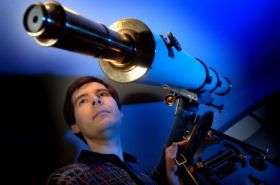Catch a new planet

Is there anybody out there? Could the Universe contain lots of other planets like ours? Are there new worlds yet to be discovered?
A live display developed by scientists from the University of St Andrews will allow visitors to monitor the live search for planets, and perhaps even witness the discovery of a new world at the 2008 Royal Society Summer Science Exhibition.
Dr Martin Dominik, Royal Society University Research Fellow at the University of St Andrews and lead developer said, "In less than 15 years, the number of planets known outside the Solar system has risen from none to more than 300.
"Now we turn the search for other worlds into a public event. Rather than confining current information about ongoing experiments to the walls of our laboratories, we allow anyone to see what we are doing and watch potentially exciting discoveries developing."
The St Andrews team employs a technique called gravitational microlensing in their hunt for planets orbiting stars other than the Sun.
Dr Dominik, of the School of Physics & Astronomy explained, "The detection of planets by gravitational microlensing means that we are waiting for a short blip in the light of an observed star that results from the gravitational bending by the planet and its host star which intervene the line of sight."
Using this technique, the St Andrews planet hunters made essential contributions to the detection of planet OGLE-2005-BLG-390Lb, which was, at the time of its discovery, the most Earth-like extra-solar planet known, providing the first observational hint at such planets being common in the Universe.
Dr Dominik continued, "Gravitational microlensing is a promising approach towards the first detection of an Earth-mass planet, which could happen at any time now. In fact, microlensing is the only technique that can currently detect planets substantially below the mass of Earth."
Within minutes of the observations being completed, the respective data are modelled and visualized, providing information to members of the public and to the scientists simultaneously. Moreover, any potential planetary signal is readily identified to ensure that planets are properly identified or dismissed.
The underlying software is an integral part of the expert system constituting the core of ARTEMiS (Automated Robotic Terrestrial Exoplanet Microlensing Search), coordinated by Dr Dominik. The data themselves flow in from all current microlensing observing campaigns that monitor stars in the central regions of the Milky Way in the hunt for planets, with the St Andrews astronomers playing key roles in several of these.
Prof Keith Horne, who pioneered the use of robotic-telescope networks for microlensing planet searches, said, "Robotic Telescopes were always extremely cost-efficient and allowed human resources to be spent on the science rather than manual tasks.
"Now that powerful software is being put in place, we are ready to move forward with a next generation of microlensing planet searches for which human judgement would be incapable of keeping track with the acquired volume of data."
For all those unable to visit the exhibition in London, live planet hunting and further information will be available on www.artemis-uk.org/targetview.html
Dr Dominik said, "We also do home delivery. Live planet hunting by microlensing is also shown on the web along with further information."
Source: University of St Andrews





















